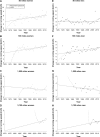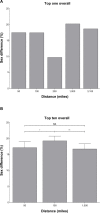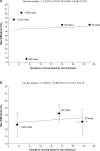Performance differences between sexes in 50-mile to 3,100-mile ultramarathons
- PMID: 25653567
- PMCID: PMC4309798
- DOI: 10.2147/OAJSM.S76490
Performance differences between sexes in 50-mile to 3,100-mile ultramarathons
Abstract
Anecdotal reports have assumed that women would be able to outrun men in long-distance running. The aim of this study was to test this assumption by investigating the changes in performance difference between sexes in the best ultramarathoners in 50-mile, 100-mile, 200-mile, 1,000-mile, and 3,100-mile events held worldwide between 1971 and 2012. The sex differences in running speed for the fastest runners ever were analyzed using one-way analysis of variance with subsequent Tukey-Kramer posthoc analysis. Changes in sex difference in running speed of the annual fastest were analyzed using linear and nonlinear regression analyses, correlation analyses, and mixed-effects regression analyses. The fastest men ever were faster than the fastest women ever in 50-mile (17.5%), 100-mile (17.4%), 200-mile (9.7%), 1,000-mile (20.2%), and 3,100-mile (18.6%) events. For the ten fastest finishers ever, men were faster than women in 50-mile (17.1%±1.9%), 100-mile (19.2%±1.5%), and 1,000-mile (16.7%±1.6%) events. No correlation existed between sex difference and running speed for the fastest ever (r (2)=0.0039, P=0.91) and the ten fastest ever (r (2)=0.15, P=0.74) for all distances. For the annual fastest, the sex difference in running speed decreased linearly in 50-mile events from 14.6% to 8.9%, remained unchanged in 100-mile (18.0%±8.4%) and 1,000-mile (13.7%±9.1%) events, and increased in 3,100-mile events from 12.5% to 16.9%. For the annual ten fastest runners, the performance difference between sexes decreased linearly in 50-mile events from 31.6%±3.6% to 8.9%±1.8% and in 100-mile events from 26.0%±4.4% to 24.7%±0.9%. To summarize, the fastest men were ~17%-20% faster than the fastest women for all distances from 50 miles to 3,100 miles. The linear decrease in sex difference for 50-mile and 100-mile events may suggest that women are reducing the sex gap for these distances.
Keywords: running; running speed; sex difference; ultraendurance.
Figures







Similar articles
-
Will women outrun men in ultra-marathon road races from 50 km to 1,000 km?Springerplus. 2014 Feb 18;3:97. doi: 10.1186/2193-1801-3-97. eCollection 2014. Springerplus. 2014. PMID: 24616840 Free PMC article.
-
Runners in their forties dominate ultra-marathons from 50 to 3,100 miles.Clinics (Sao Paulo). 2014 Mar;69(3):203-11. doi: 10.6061/clinics/2014(03)11. Clinics (Sao Paulo). 2014. PMID: 24626948 Free PMC article.
-
Performance and Age of the Fastest Female and Male 100-KM Ultramarathoners Worldwide From 1960 to 2012.J Strength Cond Res. 2015 May;29(5):1180-90. doi: 10.1519/JSC.0000000000000370. J Strength Cond Res. 2015. PMID: 24476771
-
Master runners dominate 24-h ultramarathons worldwide-a retrospective data analysis from 1998 to 2011.Extrem Physiol Med. 2013 Jul 1;2(1):21. doi: 10.1186/2046-7648-2-21. Extrem Physiol Med. 2013. PMID: 23849415 Free PMC article.
-
Ultramarathon runners: nature or nurture?Int J Sports Physiol Perform. 2012 Dec;7(4):310-2. doi: 10.1123/ijspp.7.4.310. Int J Sports Physiol Perform. 2012. PMID: 23197583 Review.
Cited by
-
Sex-specific differences in performance and pacing in the world's longest triathlon in history.Sci Rep. 2025 Aug 6;15(1):28688. doi: 10.1038/s41598-025-14578-9. Sci Rep. 2025. PMID: 40770400 Free PMC article.
-
Participation and Performance Analysis in Children and Adolescents Competing in Time-Limited Ultra-Endurance Running Events.Int J Environ Res Public Health. 2020 Mar 3;17(5):1628. doi: 10.3390/ijerph17051628. Int J Environ Res Public Health. 2020. PMID: 32138338 Free PMC article.
-
Race course characteristics are the most important predictors in 48 h ultramarathon running.Sci Rep. 2025 Mar 29;15(1):10901. doi: 10.1038/s41598-025-94402-6. Sci Rep. 2025. PMID: 40157985 Free PMC article.
-
Physiological Changes, Activity, and Stress During a 100-km-24-h Walking-March.Front Physiol. 2021 Mar 11;12:640710. doi: 10.3389/fphys.2021.640710. eCollection 2021. Front Physiol. 2021. PMID: 33776795 Free PMC article.
-
Do Sex Differences in Physiology Confer a Female Advantage in Ultra-Endurance Sport?Sports Med. 2021 May;51(5):895-915. doi: 10.1007/s40279-020-01417-2. Epub 2021 Jan 27. Sports Med. 2021. PMID: 33502701 Review.
References
-
- Whipp BJ, Ward SA. Will women soon outrun men? Nature. 1992;355(6355):25. - PubMed
-
- Bam J, Noakes TD, Juritz J, Dennis SC. Could women outrun men in ultramarathon races? Med Sci Sports Exerc. 1997;29(2):244–247. - PubMed
-
- Cheuvront SN, Carter R, Deruisseau KC, Moffatt RJ. Running performance differences between men and women:an update. Sports Med. 2005;35(12):1017–1024. - PubMed
LinkOut - more resources
Full Text Sources
Miscellaneous

